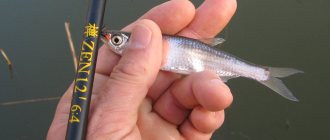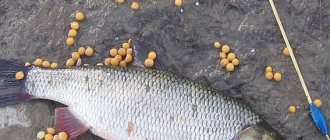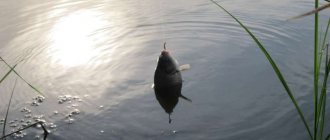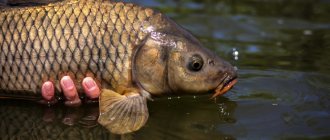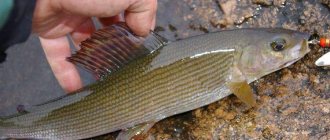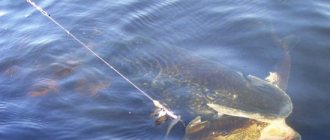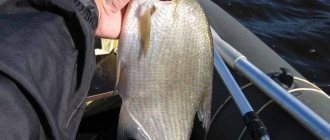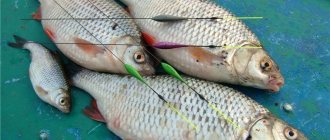In winter, different types of fish behave differently. Some hibernate throughout the cold season, and catching them becomes too problematic. Others remain active all winter, presenting great interest to anglers. And bream is closer to the latter - all winter it roams water bodies in search of food. Therefore, fishing for bream in winter with the right approach is likely to be successful and productive. However, be prepared for the fact that with the advent of cold weather, the bream does not lose its caution and does not weaken - it quickly adapts to new conditions, so you will need skill at all stages from feeding to fishing.
Winter attractant DELFI DIP WINTER SPRAY UNIVERSAL (universal, shrimp flavor, 30 ml) Tayur 80 for 1 pc. Winter bite activator. PELICAN Bloodworm (PE-045) PELICAN 242 for 1 pc. Winter attractant DELFI DIP WINTER GEL BIGFISH (big fish, worm flavor, gammarus, 20 ml) Tayur 103 for 1 piece. Aroma gel spray MIX 313 Bream (1 fl.-50 ml) (PDZ-010) PELICAN 206 for 1 pc. Winter attractant DELFI DIP WINTER GEL UNIVERSAL (universal, bloodworm flavor, 20 ml) Tayur 103 for 1 pc. Winter attractant DELFI DIP WINTER SPRAY UNIVERSAL (universal, bloodworm flavor, 30 ml) Tayur 80 for 1 pc. Winter attractant DIP WINTER SPRAY CRUCIAN (crucian carp, garlic flavor, 30 ml) Tayur 80 for 1 pc.
The most effective winter flavors
Bream fish - description
This is a fairly large inhabitant of freshwater bodies, growing up to 80 cm in length. The maximum weight is 6 kg; these were caught in Russia on the Vyatka River back in 1951 and on Lake Ladoga in 2003. Now, unfortunately, such “monsters” are no longer found, but getting a 3-kilogram trophy is quite possible.
It is not difficult to distinguish bream from other representatives of the ichthyofauna. He has a tall, laterally compressed body. The distance from the bottom to the top point is approximately 1/3 of the entire length. The height is also added by the narrow dorsal fin, sticking out from above, like a sail.
In addition to the powerful body formed due to life on the current, the following external signs are characteristic of an adult individual:
small head with a “telescopic” mouth (extends into a tube);- pharyngeal teeth arranged in one row;
- dense thick scales, cast in a brownish-silver tint in the upper part of the body (back, sides);
- light, slightly yellowish belly;
- deep bifurcation of the caudal fin (lower half longer);
- gray color of all fins.
Bream is not a predator. There have been cases when large specimens were caught on live bait or miniature spinning bait, but this is a rare exception. The fact that this is a non-predatory fish is indicated by the shape of its mouth, which stretches like a corrugated tube. With such a mouth it is easier to find food in the bottom soil. Body height also plays an important role; thanks to it, the bream becomes uninteresting to predators from a certain age.
Habitats
This fish is found in water bodies of Central and Northern Europe, in Transcaucasia, and in the southern regions of China. The most numerous populations live in calm rivers belonging to the basins of the Black, Caspian, Azov, Baltic and Aral seas. Many bream live in the Amur and its tributaries, in Lake Baikal and other large bodies of water.
As a permanent location, a school of bream chooses a section of a river with a relief silty (clayey) bottom, relatively calm water, a depth of at least 2 meters and a good food supply. She can also settle in a quiet bay, which she leaves twice a year when she goes to spawn and winter. In addition, this fish can live in large closed reservoirs: oxbow lakes, lakes, and reservoirs. The main conditions are comfortable depth and temperature, clean water, good oxygen conditions.
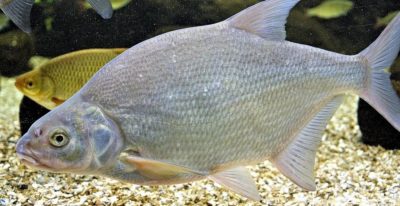
Bream is a pronounced homebody, accustomed to one place. He has his own “paths” and “corridors” along which he walks to the “dining room”, then returns back (to where he rests) so that after a certain time he again goes to feed. This must be taken into account when choosing a fishing spot. It is very important to determine, if not the “dining room” where the school feeds, then at least the passages at the bottom along which it moves. Fishing in a beautiful, convenient, but unpromising place will not yield results, because no bait or flavoring will force a couch potato to change his habits and deviate from his favorite route. The only thing that can make him leave his usual place is a change in conditions. For example, pollution or a significant decrease in water levels.
With such dependence on location, bream still have daily migrations. In the late afternoon or after dark, the flock may leave the deep channel zone and move to the shore edges in search of food. At night, this fish can also be found on grassy reaches and shallows, but before dawn it will return back to the depths.
Reproduction
Bream begins to spawn at 3-4 years of age, laying eggs in shallow water that is overgrown with aquatic vegetation. The spawning process begins when the water temperature reaches 12-15 degrees. In northern and central Russia this is mid-May. Fishermen determine the exact breeding time of bream by looking at the willows: when the leaves bloom.
One female is capable of laying up to 340,000 eggs. Larvae appear on average after 5 days. During spawning, bream is almost impossible to catch, but after breeding it actively bites and does not get sick.
Bream is a fast-growing fish, which by the age of 10 is 70-75 centimeters in length and weighs up to 8 kilograms. Fish growth rates may vary depending on habitat and feeding conditions.
Breams that live in southern latitudes grow much faster. For example, individuals living in the lakes of the Republic of Karelia reach an average body length of 24 centimeters by the age of 5, while fish living in the Volga River basin can grow up to 30-34 centimeters in length. This is a significant difference.
Bream behavior throughout the season
This “family” fish never lives alone. Individuals of approximately the same age flock together and keep to themselves, like some kind of river aristocracy. Large flocks form in the second half of autumn, when the beauties have gained enough fat and are ready for the winter. They move to the wintering pits in a line, again along well-known well-trodden paths, and not directly.
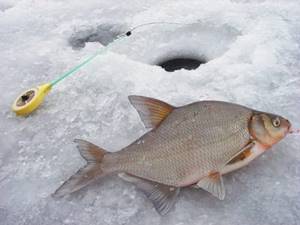
In winter, bream does not fall into a state of half-sleep like carp or catfish and does not bury itself in a thick layer of silt, as crucian carp does. Moreover, if the winter turns out to be warm, he continues to move within the wintering hole and graze on everything that comes across. Now no one doubts that he bites in winter. On the ice you can often see tents of breamers who sit above the holes waiting for a bite, periodically throwing bait into them. Recently, winter fishing with a pull-down (another name is a combine) has become popular. It works by analogy with the feeder. If you place several combine harvesters in a wintering pit, a good catch is guaranteed.
With the first warm temperatures in March, when streams of melt water rush under the ice, bream leave their wintering grounds and slowly move upstream to their spawning grounds. Along the way, they eat heavily to regain strength and prepare for the upcoming spawn. After it, the flock returns to its summer camp and does not leave it until cold weather arrives.
Baits for large bream
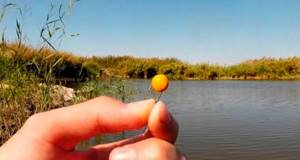
Bream is an omnivorous fish, so it can be caught with any bait, both plant and animal, but depending on the time of year. In spring and autumn, when the water has not yet warmed up, the fish gives preference to high-calorie foods, and with the arrival of summer, the fish are more focused on vegetable baits, in the form of corn, peas, mastyrka, pasta, etc. There are times when fish refuse individual, specific baits.
Then a “sandwich” is placed on the hook, which can consist of various combinations of baits, both animal and plant origin.
Tips for catching large bream in summer
- Corn is placed on the hook . It's better if it's canned corn like Bonduelle. As a rule, several grains are placed on the hook at once. As an option, a “hair” type rig, which is used for catching carp or carp, is suitable. If you also put foam on the hook, this can significantly intensify the bream’s bite, since the bait will not lie on the bottom, but will be located in the water column. The color of the foam should be the same as the color of the main bait.
- The bait used is peas . Bream also does not refuse peas if you offer them to them. The main thing here is to cook the peas so that they are not raw and do not have time to boil. Experienced fishermen know how to do this and how long to cook peas. To make the bait more attractive to bream, add a little salt and sugar to it while cooking the peas. For half a kilo of the finished product, add two tablespoons of sugar and one tablespoon of salt.
- pasta as bait , which is considered an excellent summer bait for catching bream. There are many different shapes of pasta, but star-shaped pasta is considered the most suitable. Before fishing, you simply pour boiling water over them for half an hour and that’s it, the bait for bream is ready.
How to cook pasta for fishing [salapinru]
- You can use mastyrka, which is also capable of attracting large bream. Preparing such a nozzle requires some time and experience. In addition, you can add one of the aromas to the mastyrka, although even without it this type of bait shows excellent results in terms of catchability.
A catchable bait for bream, crucian carp, carp, roach. Pea mastyrka and hominy for fishing.
Baits for catching large bream in spring and autumn

- To crawl out . It is quite large in size, so there will be no bites from small fish. They are mined at night, in conditions of high humidity or after rain. If you use a crawler, you can always count on catching a trophy specimen.
- On a dung worm . Many species of fish, including bream, love the dung worm. But since the bait is not large, small fish may be the first to appear near the bait. During fishing, it can pretty much wear down the fisherman’s nerves. To prevent this from happening, several dung worms are placed on the hook at the same time, which form a kind of cluster. In this case, a small fish, with all its desire, will not be able to cope with this bait, but for a large bream this bunch is just right.
- For maggots . Maggot is a universal bait that is considered the favorite dish of any fish. Three to five maggots should be placed on the hook. The disadvantage of this bait is that it bites, and quite often, from smaller fish. It won’t work to plant maggots in a bunch like worms, so you need to be prepared for bites from other species of fish, smaller ones.
- On bloodworms . You can also really catch a large specimen with this bait if it gets to the bait first. In this case, you should count more on bites from small and medium-sized fish. Bloodworms are considered to be a rather fragile small bait that cannot be placed on a hook so that it stays in the water for a long time. In addition, its attachment requires thinner hooks, but for catching large bream, it is advisable to have strong hooks. A tool such as a bundle knitter can solve this problem. With its help, a whole bunch of bloodworms is placed on the hook, which is inaccessible to the “little things”.
Nutritional Features
The bream absorbs small food components with the help of its extending mouth. Food is retained by gill rakers located along both arches. At the same time, water is pushed out through the gill covers. He will not refuse large food items of plant or animal origin. In addition to zooplankton, its diet includes:
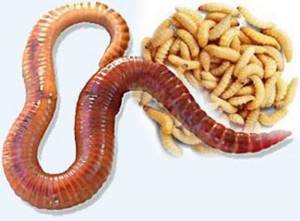
bottom invertebrates (worms, larvae);- small crustaceans;
- aquatic vegetation;
- caviar of other types.
Good fishing can be done near villages in river areas that serve as watering holes for livestock. Animals enter the water and leave excrement that attracts bream. In such places, the bite can continue around the clock, since more than one flock visits them. At the same time, adult individuals displace young animals from the “banquet”, which means that the chances of getting a trophy increase.
How does this fish feed? The feeding group moves above the bottom surface, choosing from the silt everything that can be eaten. After such a procession, nothing remains in the ground, only a completely cleared “road”. Bream's meal can sometimes be seen from the shore; it is revealed by numerous bubbles on the surface of the water. Experienced fishermen always notice such signs and remember the promising point. As mentioned above, bream does not change its habits; if it feeds here, it feeds regularly. He almost never makes forays into uncharted territories.
Spawning
Puberty can occur either at 3 years or at 9 years, it all depends on climatic conditions. In the warmest regions, this fish is ready to reproduce at the age of 3-4 years.
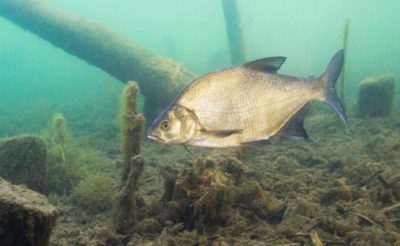
In the European part of our country, spawning begins in the first half of May. In front of him, the bream are divided into age groups, which take turns leaving to spawn. It is not typical for this species to travel long distances to spawning grounds; as a rule, they are located near the place of permanent dislocation, in a coastal zone overgrown with grass or in areas of a reservoir with identical conditions. Let us remind you that this means an abundance of vegetation and a shallow depth, thanks to which the eggs will be in the water at the required temperature. It was also noticed that the males are the first to arrive at the spawning ground, and the females follow them. The former are easily identified by numerous warts on the head.
Spawning lasts almost a month. Due to the vagaries of the weather, it may be shifted in time, but no more than a week. Each female lays up to 150,000 eggs of a barely noticeable yellowish tint. Such high productivity makes it possible to maintain numbers at the same level even in those reservoirs where active industrial fishing of this fish is carried out.
Lifestyle
Lifestyle of bream
Bream
is a large and schooling fish of commercial importance. The largest bream live in lakes and reservoirs; in rivers they rarely reach a weight of more than 4 kg. It feeds here in the greatest depths on the bottom, covered with silt and free of algae.
The beginning of bream spawning coincides with the opening of willow leaves, sometimes with its flowering, and ends with the flowering of gardens. After spawning, they feed at spawning sites, often eating the eggs of pike and perch. Bream spawning begins at a water temperature of 12-16°C, at the end of April - in May in the south, at the end of May - in June in the north. Semi-anadromous bream rises from the sea to spawn in rivers and lays eggs on the vegetation of the so-called dams on the Don and hollows on the Volga, freshly flooded with flood waters. Male bream mature earlier than females, and smaller fish on spawning grounds are usually male, and are also easily distinguished by their well-developed “pearl rash” on the head and sides of the body. Spawning of bream occurs with noisy bursts, usually early in the morning in shallow water among thickets of underwater or freshly flooded vegetation. Bream jump out of the water and fall flat into the water; the sound of spawning bream can be heard over a long distance. This splashing into the water (“leskanie” or “la-skane”) was the reason for the name of the fish “bream” or “lyash” (and in Slovakia - “pleskac”). Spawning begins and ends amicably; more often it lasts one day, from morning to noon.
In the basins of the Baltic, Caspian, Azov, and Black Seas, resident and anadromous bream spawn simultaneously; bream of the Aral Sea, in the Farkhad Reservoir, spawn in batches. The female lays an average of 100-150 thousand eggs, which attach to vegetation. In lakes and reservoirs, small immature bream and roaches stay on the spawning grounds of bream, perhaps partly picking up eggs. In many lakes, several approaches of bream to spawn are observed. Breams of different approaches may have special names reflecting the relationship between the time of bream approach to spawning and phenological phenomena; for example, the oak bream spawns when the oak leaves bloom. Larvae hatch from the laid eggs after 3-6 days.
In the brackish areas of the southern seas, bream feeds on crustaceans: mysids, cumaceans; in the diet of bream in the Sea of Azov, in addition, polychaetes are of great importance. The food of bream in the Aral Sea is amphipods, chironomid larvae, and mollusks. In lakes, bream feed on the larvae of chironomids, caddis flies and other insects, and pea mollusks. In lakes and reservoirs, the spawning time of bream is close to the spawning time of other fish, and therefore hybrids often appear.
The number of bream in different reservoirs varies greatly and depends primarily on the success of spawning. A favorable condition for bream spawning in the southern seas is high floods. After the regulation of the flow of rivers in the southern seas, spawning areas for bream were greatly reduced. To preserve bream stocks at a high level, special spawning and rearing farms have been created, and work is being carried out to rescue juveniles from small reservoirs that have become isolated and have lost connection with the river. In reservoirs, numerous generations of bream appear in high-water years. To ensure the spawning of bream in reservoirs, floating spawning grounds are used.
How to catch bream?
Fishing for bream is a fascinating activity that requires a competent approach. To successfully catch a handsome river fish, you need to solve many riddles. Only attentive, thoughtful and purposeful fishermen succeed in this. Most of them prefer to fish away from civilization and city noise, where no one disturbs quiet, leisurely fishing. The tactics are wait-and-see, the main rule is caution, maximum secrecy. The fisherman should not give away his presence by a flashing silhouette, stomping, crunching of breaking branches or tobacco smoke. This is the only way to hope for success. Another quality of the bream is perseverance and patience. The time from the first cast to the first bite is sometimes calculated in hours.
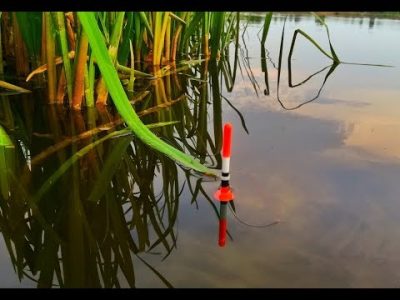
How to catch bream? In those areas of the reservoir where the channel zone runs close to the shore, you can use float gear, which has the best sensitivity. A thin, light, but strong fishing rod 4 to 6 meters long with guide rings and a small spinning reel is suitable. The equipment consists of a 0.20 mm main line, a dim “wagler” type float with a carrying capacity of no more than 2-3 g, a float limiter, a load of several pellets, a 0.16 mm leash and a reliable hook corresponding to the size of the bait used. When fishing in the current, instead of a fishing line, you can use a thinner braid (0.10 or 0.12 mm). She doesn't sail that much.
The bream bites carefully. Having noticed the bait, it swims up to it, assumes a tail-up position, extends its “telescopic” mouth and begins to slowly suck it in. At this moment, a raised pod signals the beginning of a bite. The float first tilts, then rests completely on the water, and if the fish with the bait moves to the side, it sinks at an angle of 30-40 degrees. You can hook it only when it is completely lying on the surface of the water. This means that the bait is in the mouth of the potential prey.
Another useful tackle is a feeder, with which you can fish at long distances, great depths and strong currents, where a float rod is not applicable. Standard feeder kit includes:

carbon fiber rod with replaceable tips;- spinning reel;
- cord with a diameter of 0.16-0.20 mm;
- special feeder installation (asymmetrical loop, paternoster and others).
The installation, in turn, consists of a feeder, a piece of fishing line, a leash, a hook and fittings. The feeder can be metal, plastic, in the form of a rag mesh, square, oval, cone-shaped, with or without lugs. This is a very important element of the tackle; it literally shows the bream the way to the bait. The feeder is filled with bait mixture. Gradually being washed away by the water flow, it creates a trail of bait along which the fish approaches.
Baits in feeder fishing, as well as in float fishing, are dung and earthworms, maggots, bunches of bloodworms, pea mastyr, steamed pearl barley, store-bought or homemade poufs (dry dough). This is a fairly active type of fishing, requiring frequent recasts. And if the bite is good, you definitely won’t be bored.
Features of seasonal fishing on a feeder
The behavior of bream is directly related to the current time of year. Depending on the season, it is necessary to observe a number of subtleties when fishing with a feeder.
Spring
The feeder should be used when the temperature of the reservoir rises to 10 degrees. The fish begin to swim in the shallows and prefer mainly animal bait. A worm or maggot will do.
The end of April is marked by an almost complete absence of bite. The reason for this is spawning. The activity of bream appears already at the end of May, immediately after the end of spawning. At this time, the bream returns to its usual places. As a rule, these are holes and depressions in reservoirs. It is at depth that you should look for bream in late spring.
Summer
Starting from June, it begins to actively search for food. The most favorable start for fishing is considered to be mid-June. Not hot enough for the bream to go too deep, but warm enough for the fish to be active. It is necessary to examine the bottom of the reservoir in advance for holes and depressions.
An echo sounder is the ideal device for this, although a marking rod will also work. Preparing a feeder and fishing in the summer season is not difficult; all standard solutions will bring the desired result.
Autumn
Early autumn is great for feeder fishing. Bream, preparing for the winter period, actively searches for food and increasingly swims to the shores. Late autumn is characterized by a strong decrease in activity, and fishing areas are narrowed to wintering pits, in which it lives most of the time.
When it comes to bait, preference should be given to animal baits.
Weather conditions are an important factor
Weather conditions are an important factor when fishing. In case of low temperature and strong wind, the chance of successful fishing tends to zero. Hot weather greatly reduces the activity of bream, and the fish prefers to wait out it passively at depth. In such conditions, fishing may also be ineffective.
But rain, on the contrary, increases efficiency. This is due to the enrichment of the reservoir with oxygen and increased metabolism in fish. In strong winds, it is recommended to take a position in which the wind will be directed to your face and not to your back, so as not to spook the fish.
Nutritional value and health benefits
The appearance of a fish is often deceiving. Same with bream. Outwardly, it appears as thin as a bay leaf and bony, especially a young individual that has not yet gained fat (breeder). However, the meat of an adult bream contains as much as 9% fat, according to this indicator it loses only to the beluga. What are the benefits of bream fat? It retains its properties during heat treatment, which is important. Once in the human body, this unique product breaks down cholesterol plaques (that is, reduces the amount of bad cholesterol), and also cleanses blood vessels, thereby preventing the occurrence of pathologies in the organs of the cardiovascular system.

In addition to the mentioned fat, bream meat contains many minerals and vitamins necessary for our body. These are omega-3 and omega-6 acids, vitamins A, B, C, E, PP, potassium, iron, calcium, phosphorus and many other microelements that are good for health.
What is the difference between bream and white bream?
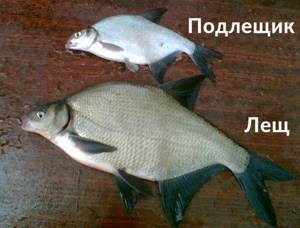
Many inexperienced fishermen are sure that bream and white bream are different species. They are very similar, but have a number of differences that will disappear over time. After all, a bream is a young individual of bream up to 3 years old. White bream form the largest population of bream. The weight of the bream varies from 300 to 700 grams. Bream are much larger than their descendants.
However, the main difference between the bream and the bream is the color of the scales. The bream has silvery scales. In an adult, the scales have a brown, bronze, reddish and golden tint. If the catch contains a fish weighing 1 kilogram, but with silvery scales, it is a bream, and if the scales have already acquired a brown tint, then it is already an adult bream. In addition, the young fish does not have a hump, which it will acquire during its life. The bream got its name because it is, under the guise of bream, a young specimen of this bottom-dwelling fish.
How to cook bream?
Experienced chefs know how to cook bream, and they are always ready to share their secrets. Below are the two best ways to prepare this tasty and healthy fish.
Bream in the oven is perhaps the most common dish. It is advisable to bake it fresh, not frozen in the refrigerator. First you should clean the fish - remove scales, entrails, gills, tail and fins. If you come across a large specimen, it is better to divide its carcass into portioned pieces.
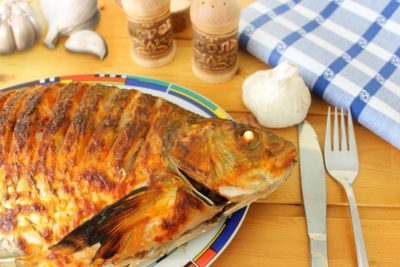
You can bake it openly, without using food foil or a special sleeve. For such a dish you will need 200 g of sour cream, lemon, a couple of medium onions, spices, salt and some herbs. A mixture is made from sour cream, lemon juice, seasonings and salt, which is rubbed on both sides of the fish and marinated for about 20-25 minutes. During this time, you can peel and cut the onion into rings and preheat the oven. Operating temperature – 180 degrees. Next, the bream is stuffed with onions, placed on a greased baking sheet and put in the oven for half an hour. After turning off the fire, it remains there for another 10-15 minutes. After this time, it is taken out, placed on a plate with a side dish (buckwheat, potatoes), decorated with herbs and served.
Dried bream has a unique taste. You can make this delicacy at home, but you need to know one small nuance. If the fish is not gutted, it will be much tastier. This is especially true for spring bream, whose belly is filled with caviar. But fish without entrails will be salted better. In general, how to salt and dry is everyone’s personal business. Let's consider drying a whole, ungutted bream.
Immediately upon arrival from fishing, the catch must be put in the freezer for one and a half to two hours. There it will cool down and get rid of parasites that are sometimes present in fish. After this you can add salt. To begin, select a suitable plastic container and completely fill its bottom with salt. Salt is also stuffed under the gills of each fish, because, as you know, it spoils from the head. That’s it, now the bream can be laid in a “head to tail” pattern, sprinkling salt on all layers. When the fish run out, all that remains is to put pressure on top, put the container in the refrigerator and wait about a week or a week and a half. Seven days is the minimum, because a quick ambassador will not give the desired result.
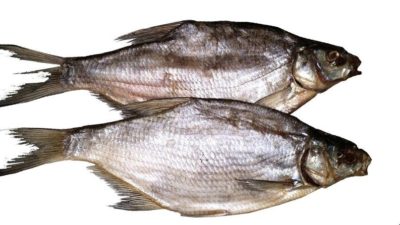
The next stage is soaking. This is necessary to remove any remaining salt. Soak the bream in a large deep container or in the bathtub if other family members agree not to use it for 24 hours. This is exactly how long this process takes. You need to soak in cold water.
After that, there's little left to do. It is necessary to hang the fish in a ventilated room, the temperature in which does not rise above 15 degrees. To create such conditions, some fishermen use a table fan. The result of your efforts will be delicious dried bream with tender meat of an appetizing amber hue.
Video on the topic:
Fishing for bream, how to catch bream, fishing for bream on a canal, good fishing
25:41
How to salt fish (bream). | How to pickle fish (bream).
03:21
Bream in the oven. Baked bream in foil in the oven. Bream baked in the oven.
06:46
FISHING IN HOT SUMMER! How to catch bream on the feeder!
38:07
narybalke

